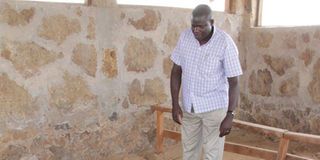Looking for a unique tourist site? Try Sibiloi

Dr Emmanuel Ndiema explains to tourists and journalists about a shell and limb bones of a giant tortoise that was excavated and being preserved at Sibiloi national park in Marsabit county during a park tour on November 3, 2013. Photo/ JOSEPH KANYI
What you need to know:
- It is probably Kenya’s most remote national park.
- It is where a team of archaeologists discovered one of the profession’s most valuable treasures, a close to 2.2 million-year-old fossilised full skull of Homo habilis, now labelled KNM-ER 1470 by the National Museums of Kenya.
Right on the edge of Lake Turkana’s windblown shoreline in the vast Marsabit County sits Sibiloi National Park. It is probably Kenya’s most remote national park. According to a National Museums of Kenya senior research scientist, Dr Emmanuel Ndiema, Sibiloi is home to the first man on earth.
Sibiloi National Park, he says, was therefore, fashioned to protect the history of the origin of man.
Koobi Fora, the palaentological site within the park, said to be three million years old, shelters many of the Homo erectus hominid fossil finds.
It is where a team of archaeologists discovered one of the profession’s most valuable treasures, a close to 2.2 million-year-old fossilised full skull of Homo habilis, now labelled KNM-ER 1470 by the National Museums of Kenya.
The skull, together with about 160 other archaeological pieces, confirmed the survival of a sophisticated evolutionary hominid, a direct ancestor of Homo sapiens — humans.
There is a universally recognised museum where these can be viewed, in addition to a tour of excavation sites led by a local guide for tourists who flock Sibiloi.
“The human fossils discovered here have long since been removed and taken to Nairobi. But the National Museums of Kenya has enclosed and protects three other fascinating fossils sites in the park that are huge tourist attractions,” says Dr Ndiema.
FOSSILS
These comprise fossils of a giant tortoise, some two million years old, an ancient species of crocodile that grew up to 15 metres, and a big-tusked behemoth, an ancestor of today’s elephant.
The petrified forest south of these sites is proof that the area was densely forested seven million years ago.
Every year the rains and the wind expose other fossils, Dr Ndiema says, adding that many of the most impressive ones are still covered by rocks and stones.
Located at an altitude of 355 metres above sea level, with a hot and arid climate — June/July are the coolest months — Sibiloi has a wide variety of game.
These include northern species of the gerenuk and oryx, Grevy’s and Burchell’s zebra, lions, striped hyena, and topi.
This is thanks to the varied vegetation, which includes grassy plains with yellow spear grass, palm trees, acacia shrubland, and desert roses.
The park also boasts some 350 bird species, including large numbers of flamingoes and northern Somalia ostrich.
It is notable that the world’s largest hippopotamus, the Nile hippopotamus, and the Nile crocodile, which are found in the area, breed on Lake Turkana’s Central Island, so if you have a special interest in crocodiles, this is the place to visit.
CENTRAL ISLAND IS A SPECTACULAR FEATURE
Located in the middle of the lake, Central Island is a spectacular feature, with a volcano and three crater lakes.
The park also has an area where crocodiles, fish, and birds that breed here are protected.
As the local headquarters of the Kenya Wildlife Service, Sibiloi National Park has a number of facilities.
In addition to the museum located near the main research camp, sightseers can take an aerial tour of Koobi Fora.
But to make the most of the park, one needs to spend several days since there is a lot to discover and experience in the area.
Sibiloi National Park is the ideal destination for those looking for something different from the traditional tourist trail.
Adventurous visitors with a thirst for the road less travelled will find their views of what Africa has to offer changed after a visit to this park.
However, due to the high number of visitors, it is advisable to book well in advance to avoid disappointment.
flocking of tourists cum travellers all accommodation is subject to availability at Sibiloi.
SAFARI ALTERNATIVES
The Safari alternatives consist of a guided fly-in tour or over landing on an extended safari through the northern frontier. Other types of expeditions should be well equipped, self-sufficient and conducted by experienced guides.
A tour around the beautiful lake roughly costs Sh3,000.
From an artistic indicate, interaction with the locals is but an unforgettable experience not to be forgotten, not to mention a very worthwhile bustle in totting up to the park visit.





